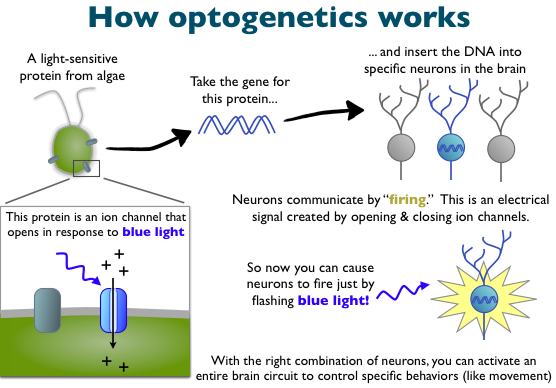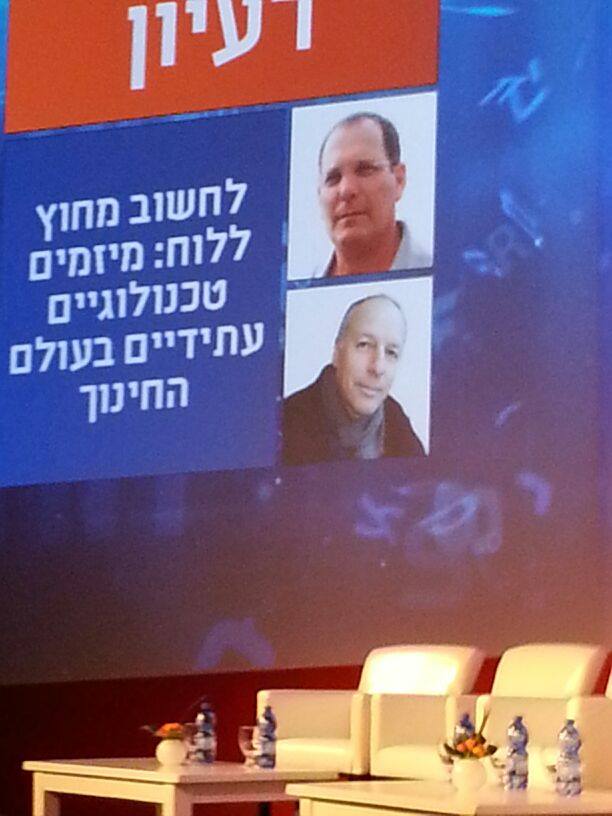Category: BCI
-

Optogenetics may enter brain therapy mainstream
http://www.npr.org/blogs/health/2013/12/26/256881128/experimental-tool-uses-light-to-tweak-the-living-brain Optogenetics, the process of controlling brain cells using light, could be used to understand and treat brain diseases, including epilepsy and depression. Previously, scientists relied on fMRI and a wire probe inserted into the brain to switch on cells. The technique must be refined before it can be used in people or in remote…
-
Microscale torsional muscle system can simulate active neuromuscular system
http://newscenter.lbl.gov/news-releases/2013/12/19/a-micro-muscular-break-through/ U.S. Department of Energy and Lawrence Berkeley National Laboratory researchers have developed a micro-sized robotic torsional muscle/motor made from vanadium dioxide. For its size, it is a thousand times more powerful than a human muscle, able to catapult objects 50 times heavier than itself over a distance five times its length within 60 milliseconds. “Multiple…
-
Crowdfunded 3-D augmented reality glasses aim to compete with Google Glass
https://www.spaceglasses.com/ For several months, after a successful Kickstarter campaign, Meta has been developing augmented reality glasses “that combine the power of a laptop and smartphone in a pair of thick Ray-Bans and a small pocket computer.” The Meta Pro will have an i5 CPU, 4GB of RAM, 128 GB of storage, Wi-Fi 802.11n and Bluetooth 4.0 connectivity.…
-

EEG patch monitors attention in students
http://www.calcalist.co.il/local/articles/0,7340,L-3619747,00.html http://www.calcalist.co.il/local/articles/0,7340,L-3620186,00.html Professor Nathan Intrator of Tel Aviv University’s Blavatnik School of Computer Science and Sagol School of Neuroscience, and Guy Levi, Chief Innovation Officer of Israel’s Center for Educational Technology are disrupting education through brain science. In an attempt to improve learning abilities in children with attention issues, Intrator and Levi attach a patch…
-
Year end review of “neuromorphic” chip prototypes
http://www.technologyreview.com/featuredstory/522476/thinking-in-silicon/ MIT Technology Review today features an overview of processors that they claim are “about to narrow the gulf between artificial and natural computation—between circuits that crunch through logical operations at blistering speed and a mechanism honed by evolution to process and act on sensory input from the real world.” Caltech’s Carver Mead pioneered “brain…
-
Nerve interface simulates touch in prosthetic hand
http://www.technologyreview.com/news/522086/an-artificial-hand-with-real-feelings/ Cleveland Veterans Affairs Medical Center and Case Western Reserve University researchers have developed an interface that can convey a sense of touch from 20 spots on a prosthetic hand. It directly stimulates nerve bundles, known as peripheral nerves, in the arms of patients. Two people have been fitted with the interface to date.…
-
Nerve impulse sensor exoskeleton assists paraplegics, Parkinson’s, stroke patients
http://www.dw.de/standing-again-with-nerve-controlled-robotics/a-17280419 Professor Thomas Schildhauer leads a team at Bergmannsheil University Clinic’s “Center for Neuro-Robotic Mobility Training” that uses nerve impulse sensors to help patients walk again. A robotic exoskeleton with sensors affixed to the hips and legs gives paraplegics, Parkinson’s and stroke patients a sense of stability during ambulatory exercises. The robot suit contains numerous sensors that…
-
Thought controlled device helps stroke patients move limbs
https://www.radiology.wisc.edu/research/currentProjects_details.php?id=368 http://www.sacbee.com/2013/12/01/5961969/novel-rehabilitation-device-improves.html Professor Vivek Prabhakaran at the University of Wisconsin is developing a device that combines a brain-computer interface with electrical stimulation of damaged muscles to help stroke patients relearn how to move limbs. Eight patients who had lost movement in one hand have been through six weeks of therapy with the device. They reported improvements in…
-
Emotion detection via expression reading algorithms
http://www.nytimes.com/2013/12/01/technology/when-algorithms-grow-accustomed-to-your-face.html The emotion reading market, based on facial recognition aglorithms, is developing rapidly. Companies in this field include Affectiva and Emotient. Affectiva used webcams over two and a half years to accumulate and classify about 1.5 billion emotional reactions from people as they watched streaming video. These recordings served as a database to create the company’s face-reading software,…
-
Tongue based magnetic field controls wheelchair
http://stm.sciencemag.org/content/5/213/213ra166 Maysam Ghovanloo of Georgia Tech and Anne Laumann of Northwestern have developed a tongue piercing based magnet to operate a wheelchair. The device is a small magnetic barbell which creates a magnetic field in the mouth. When users flick their tongues, it alters that field. The change is picked up by four small sensors…
-
Monkeys in Nicolelis lab control both arms using brain activity
http://stm.sciencemag.org/content/5/210/210ra154.short?rss=1 Duke’s Miguel Nicolelis continues to advance brain machine interface, and in his latest experiment, monkeys have learned to control the movement of both arms on an avatar using their brain activity. The findings advance efforts to develop bilateral movement in brain-controlled prosthetic devices for severely paralyzed patients. Until now brain-machine interfaces could only control…
-
“Bionic” arm exoskeleton concept for rehabilitation and strength augmentation
http://titanarm.com/about Titan Arm is an untethered, powered, upper body exoskeleton concept for use in rehabilitation and therapeutic applications, which can also augment strength. It is under development and not yet ready to be brought to market, but is being designed by students at The University of Pennsylvania. It straps directly to a user’s right arm to help…